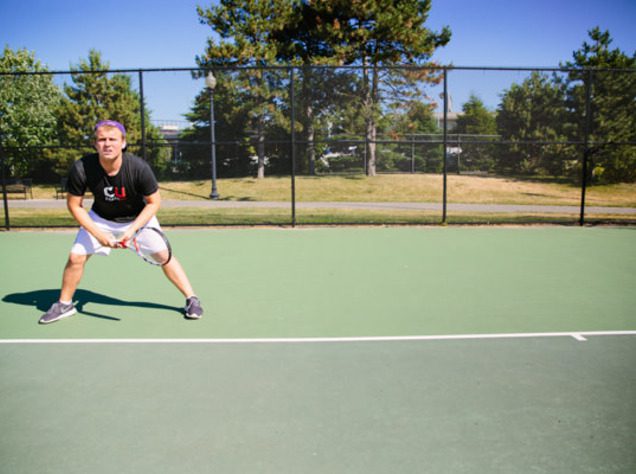When tennis players are looking to switch up their game and improve their skills, many professional coaches advise their players to learn the approach and volley technique. Not only is this technique useful for throwing your opponent off, but it’s a great way to attack and take control of the point. When approaching and volleying, players are able to put pressure on their opponent and focus on where they want to place the ball.
But becoming a fluid, well-prepared athlete is the product of hard work, dedication, and long hours of training. So, don’t be afraid to take these tips from CoachUp the next time you’re on the court. Combine them with some intense effort and you’ll take your game to another level in no time!

The Approach
By hitting a solid approach shot, it becomes much more difficult for your opponent to hit a strong passing shot past you. If your approach shot lands short and fast on your opponent’s side, there’s a high chance that they won’t be able to get to it. With approach shots, you can choose to either hit an aggressive ground stroke while moving in or approach with a drop shot if they’re positioned further back on the court.
In terms of the direction of your approach shots, coaches advise hitting it down the line. Why down the line? Well, simply enough, hitting your approach shots down the line will ultimately leave you closer to the center of any potential return shot. In tennis, every shot doesn’t need to be a potential winner, instead, try hitting shots that will give you high percentage opportunities for your next shot.
Rapid-Fire TIPS
- Preparation and movement for the approach shot is key! Make sure you’re keeping yourself in a position to succeed. Don’t run right at the ball, maintain control and keep your body balanced.
- Try to hit the ball in your upper-volley strike zone.
- When you’re closing in on a volley, move as close to the net as possible. Cover the line and react to any possible crosscourt action.
- Balls returned as high volleys should be hit to the service line crosscourt.
- Execute the lift and land footwork. This means that after you lift your racquet and hit the ball, land forward and keep your feet moving. Hop off your front foot just after you make contact with the ball.
The Backhand Approach While the forehand approach is very similar to the forehand groundstroke, many players struggle with it as a backhand. Remember, you’ll want to finish with your racket in front of you. With this shorter swing, you’re still able to get power while also maintaining control on the ball. Sink down and use your legs, making sure that your shoulders and hands are level. Next, move your body through the stroke and speed in towards the net.
The Volley
When positioning yourself to hit a powerful volley, it’s important to focus on where you’re standing. You want to make sure you’re standing between the middle of the service box and halfway to the net when executing your volley. Stand with your feet shoulder length apart and keep your body loose for any type of shot that comes to you. In terms of the distance between the body and the ball, look at it’s height. If the ball is high, you should be making contact further away from from the body.
Volleys are hit with a Continental Grip in order to get a fair amount of underspin on the ball. For more information on what a continental grip is, you can check out our resource for holding the racquet correctly. Make sure the heel of your hand is even with the handle and that you have relatively loose grip. Try choking up on the grip and move your hand up the shaft of the racquet. Hold your racquet in front of your left shoulder, so you’ll be prepared to hit either a forehand or backhand volley without much effort or thought.
EXECUTING THE VOLLEY
Perhaps most importantly, remember that the volley is based on touch, not force. Imagine catching the ball like an egg on your racquet and then pushing it with a bit of slice across the court. Stay nice and low, making sure to have proper footwork. When executing your backhand volley, use your other hand and extend it back to balance yourself while you step forward into the shot. After hitting the shot, recover back to your ready position.
Rapid-Fire TIPS
- Make sure you’re not using a backswing while hitting your forehand or backhand volleys.
- Have laser focus on where want to place each volley so that you can have your opponent scrambling to return the ball.
- Anticipate where the ball is going to come to your racquet, and have a quick response time to catch every return.
(Related: Read about utilizing a dynamic warm-up before matches here.)
Huddle Up
To an outsider, one might mistakenly confuse tennis for a sport built off of brawn. Even worse, someone might assume that the best tennis players are the ones that simply hit the ball the fastest. However, this couldn’t be further from the truth, and the best athletes are the ones with a supreme command of every shot in the arsenal. From service, to approach shots, to that killer volley Roger Federer has mastered over the years, it’s incredibly important to be able to hit any shot with certainty and confidence.
If you’re still struggling with your approach and volley shots, consider booking one of CoachUp’s private trainers to help you out. Our talented team has been hitting perfect approach shots and unhittable volleys for decades and they’ll set you straight in no time. One of the keys to success in tennis is becoming comfortable and cerebral, knowing when to use what grip or shot in a moment’s notice, and our team can help you develop in those areas. So what are you waiting for?
Be prepared for the biggest moments by mastering the small ones off the court.
How useful was this post?
Click on a star to rate it!
Average rating 5 / 5. Vote count: 1
No votes so far! Be the first to rate this post.



